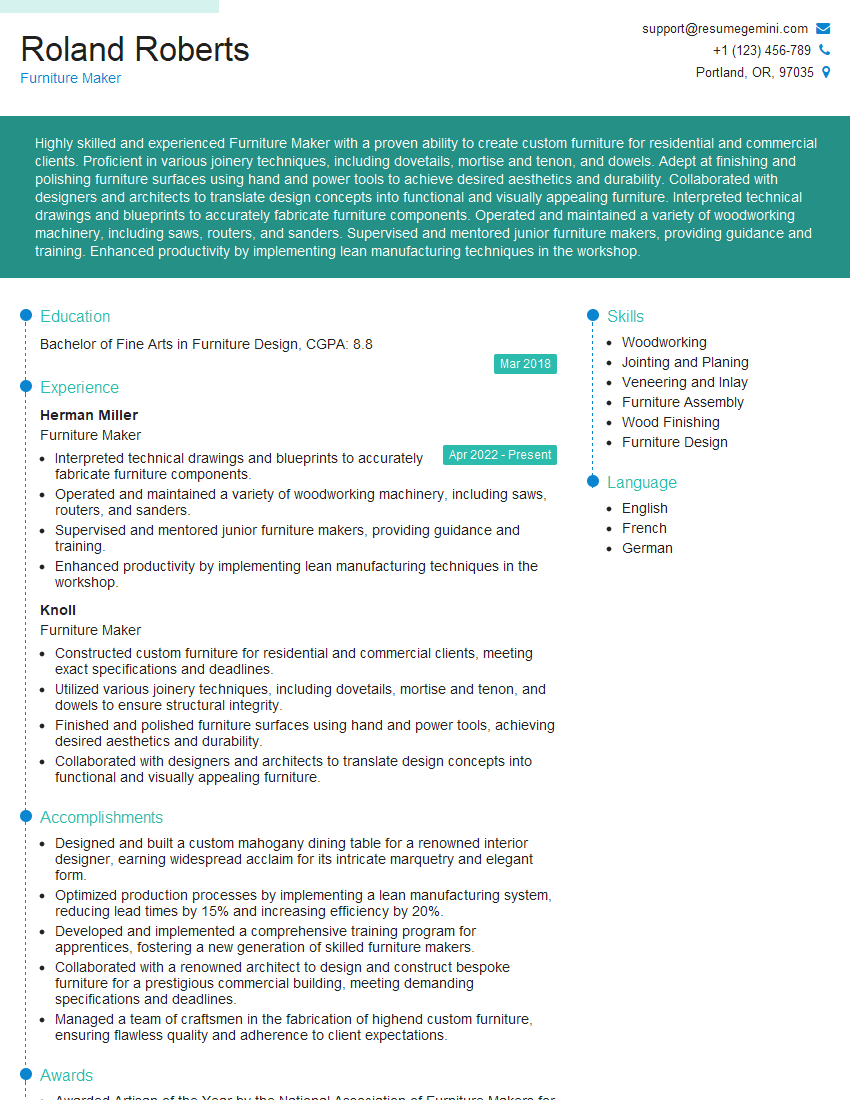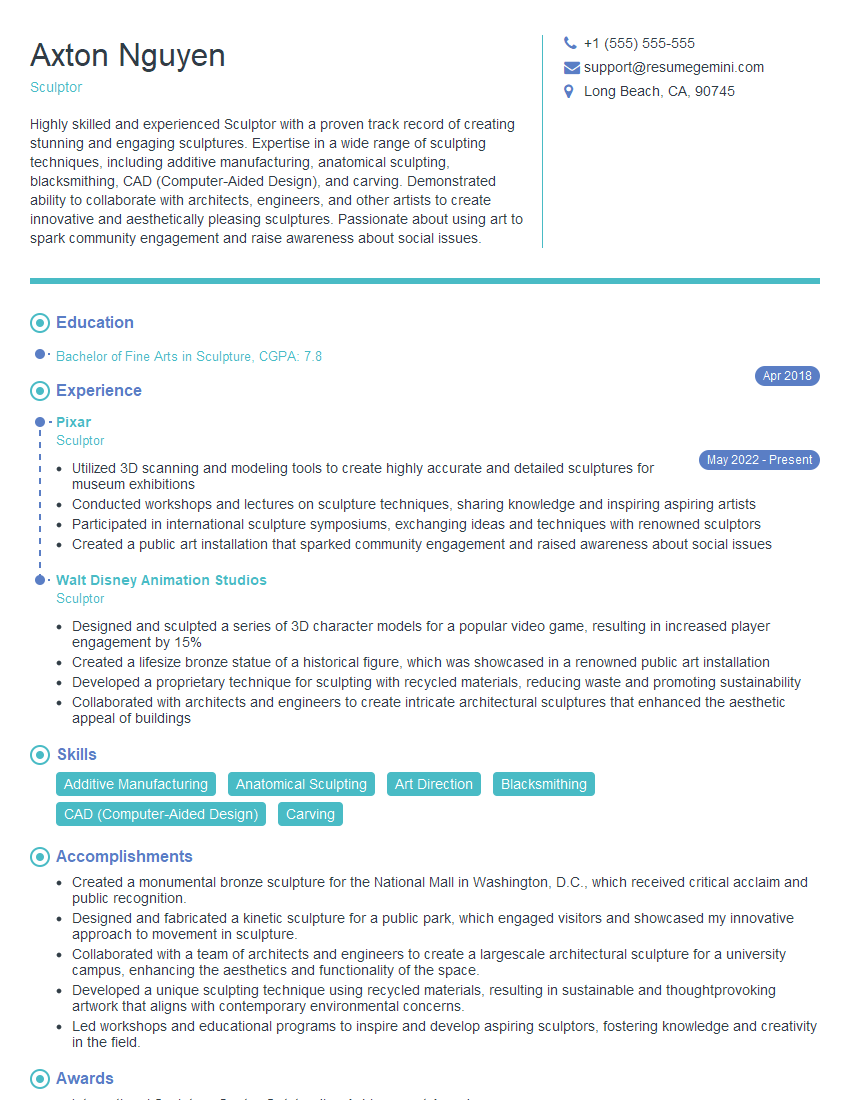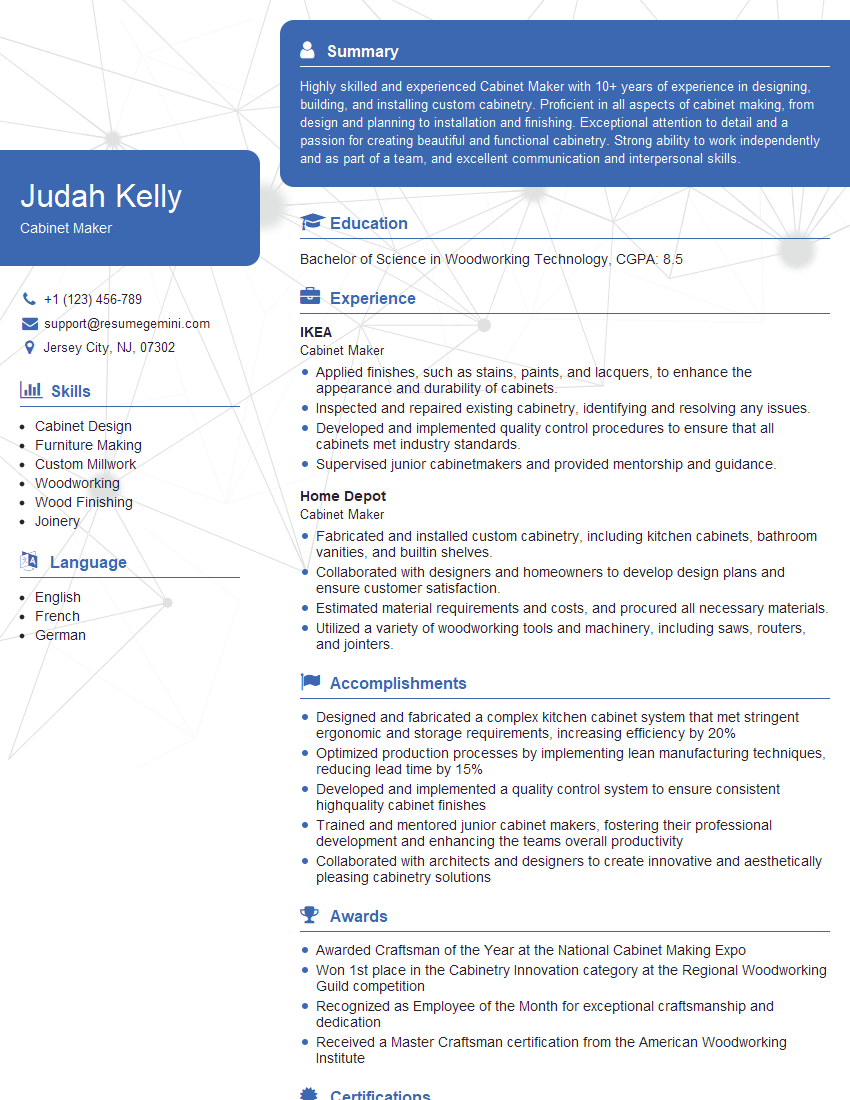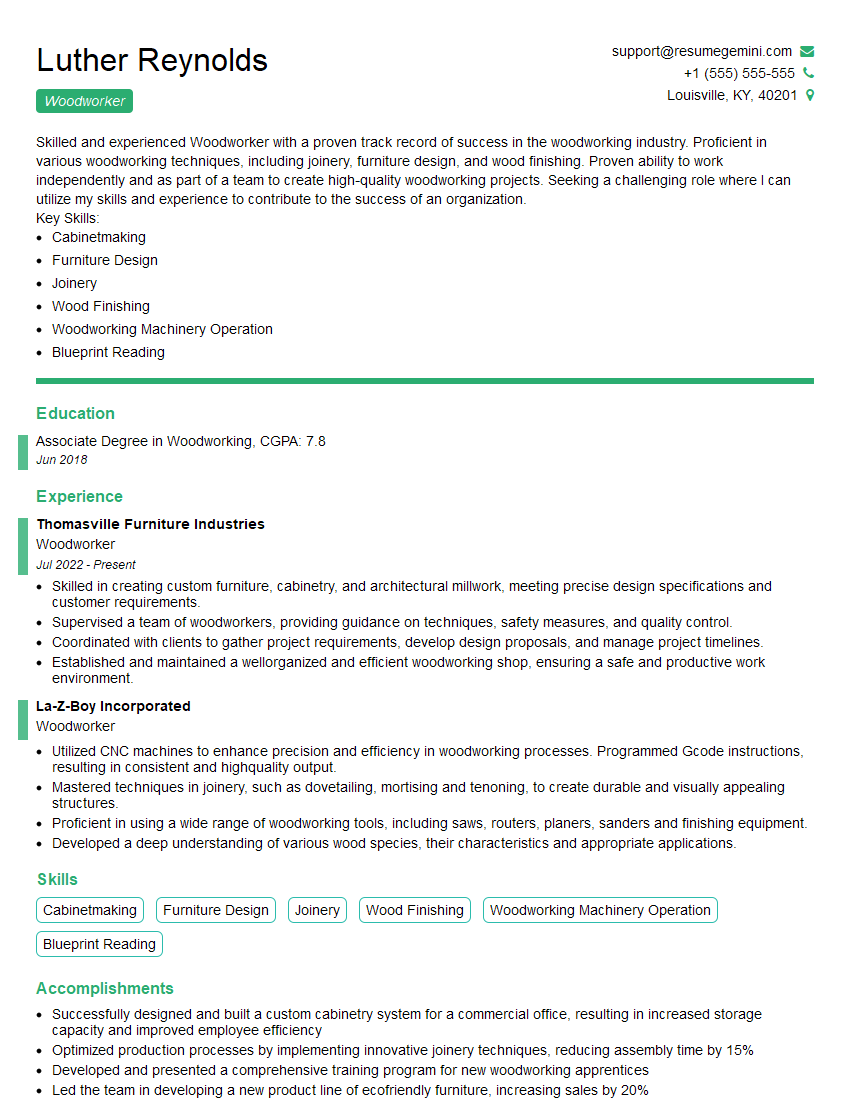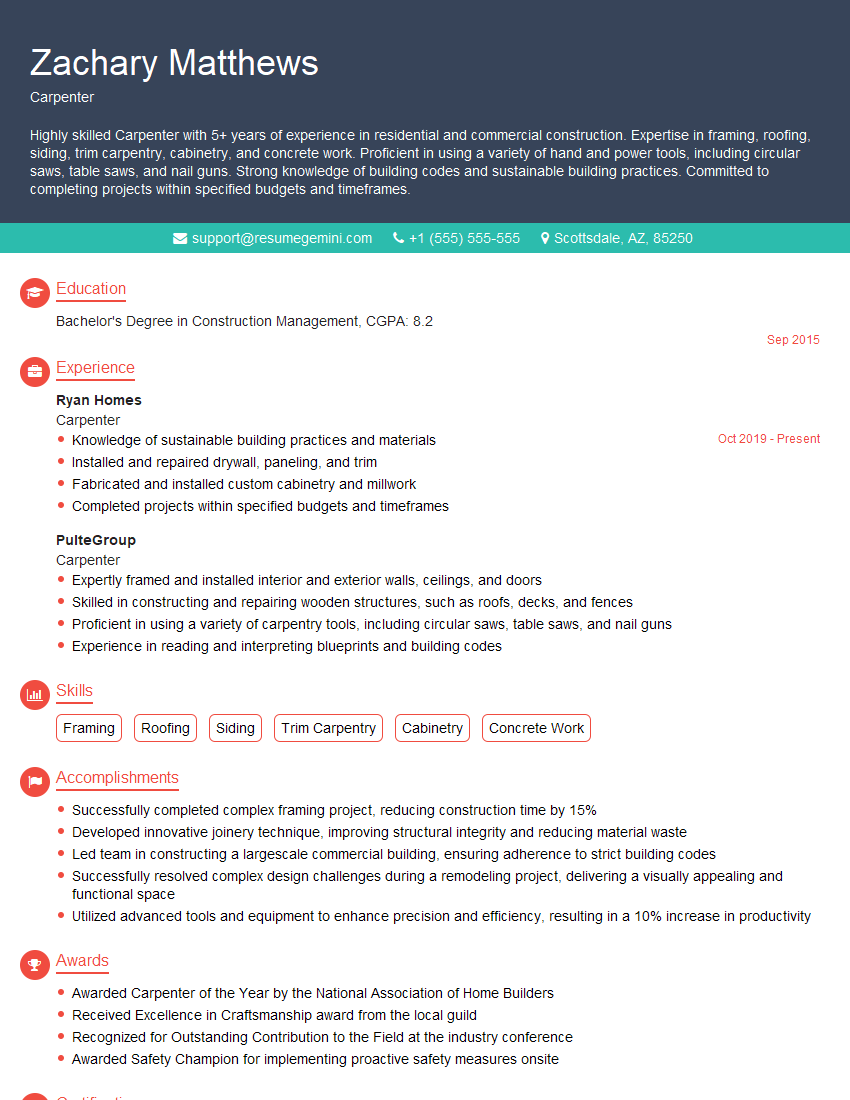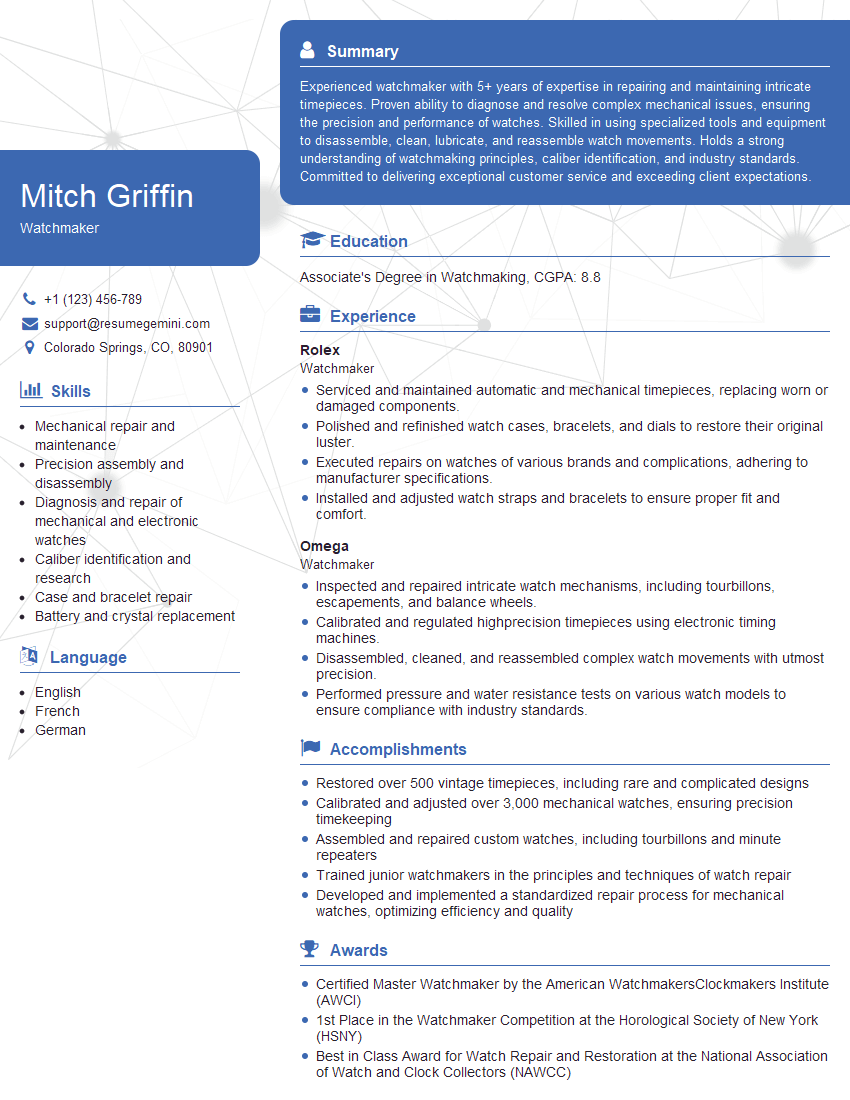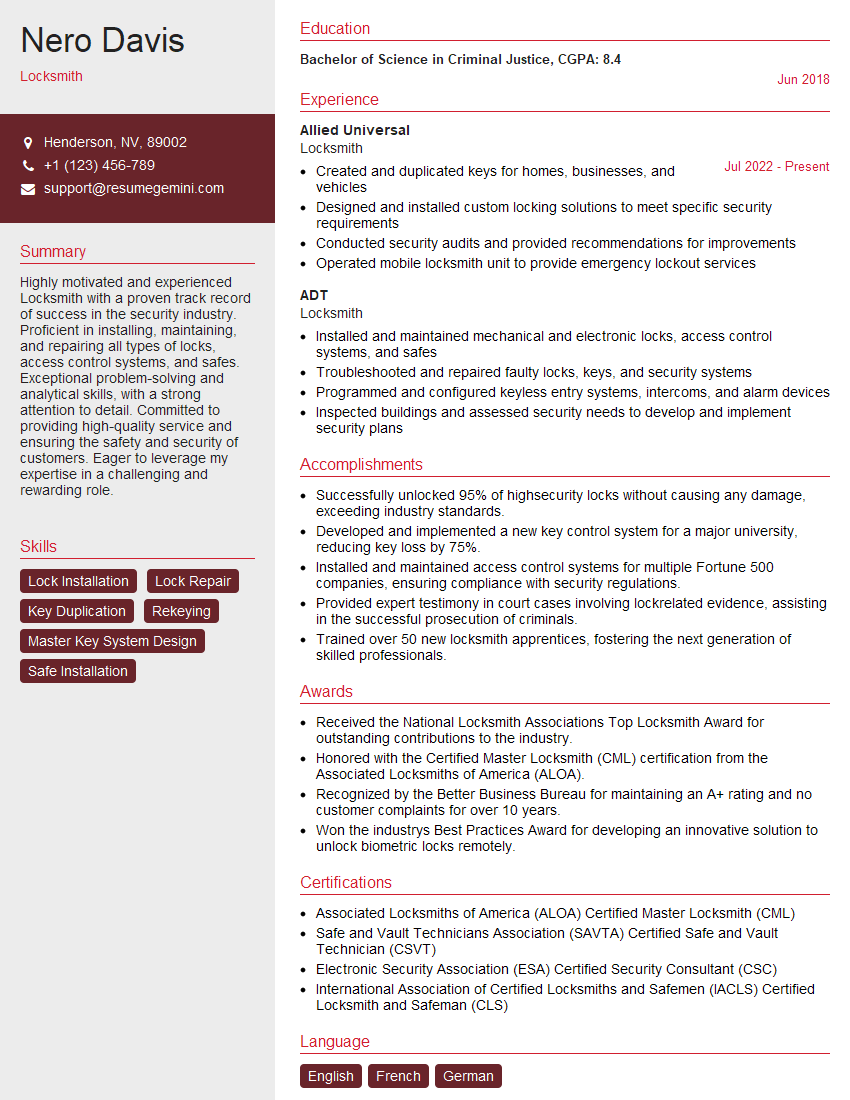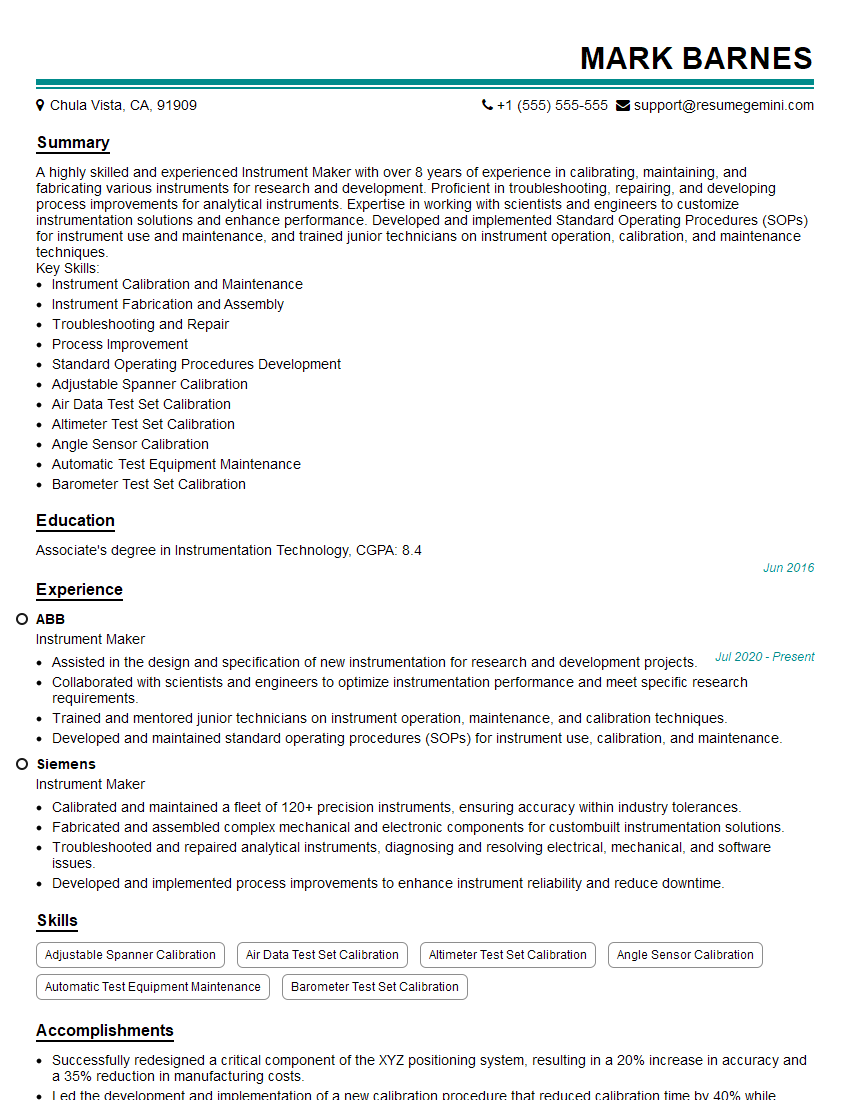Unlock your full potential by mastering the most common Hand Tooling interview questions. This blog offers a deep dive into the critical topics, ensuring you’re not only prepared to answer but to excel. With these insights, you’ll approach your interview with clarity and confidence.
Questions Asked in Hand Tooling Interview
Q 1. What safety precautions are essential when using hand tools?
Safety is paramount when working with hand tools. Think of it like this: a misplaced hammer blow isn’t just inconvenient; it can be seriously dangerous. Essential precautions include:
- Eye Protection: Always wear safety glasses or a face shield to protect against flying debris. Imagine a sliver of wood unexpectedly launching itself – safety glasses are your first line of defense.
- Hearing Protection: For prolonged use of power tools (even hand-powered ones like drills), hearing protection is crucial. Constant loud noises can cause permanent hearing damage.
- Hand Protection: Wear work gloves to improve grip and protect your hands from cuts, splinters, and blisters. Think of gloves as a second skin, providing an extra layer of protection.
- Proper Tool Use: Use each tool for its intended purpose. Don’t try to force a tool to do something it wasn’t designed for. This is like trying to use a screwdriver as a chisel – it’ll likely lead to injury or tool damage.
- Workspace Safety: Ensure your workspace is well-lit, clutter-free, and stable. A cluttered space increases the risk of accidents. A clear workspace allows for better focus and prevents trips and falls.
- Tool Maintenance: Regularly inspect and maintain your tools. Sharp tools are safer tools because they require less force, reducing the chance of slippage and injury.
Remember, a safe work environment is a productive work environment. Prioritizing safety is an investment in your well-being and the quality of your work.
Q 2. Explain the proper sharpening technique for a chisel.
Sharpening a chisel is crucial for clean cuts and efficient work. Think of it like sharpening a knife; a dull chisel requires more force, leading to imprecise cuts and potential injury. Here’s a step-by-step guide:
- Select the Right Sharpening Stone: Use a combination stone (coarse and fine grit) or two separate stones. A coarse stone removes more material quickly, while a fine stone refines the edge for a sharper finish.
- Establish a Consistent Angle: Maintain a consistent angle (typically 25-30 degrees) throughout the sharpening process. Using a honing guide can help maintain this angle consistently.
- Sharpen the Bevel: Using the coarse stone, draw the chisel’s bevel across the stone, maintaining the chosen angle. Apply even pressure and use long, smooth strokes. Repeat until a burr (a tiny metal edge) forms along the opposite side.
- Remove the Burr: Switch to the fine stone and repeat the process, this time to remove the burr and refine the edge. The goal is a smooth, polished edge.
- Honing (Optional): Use a strop or leather honing wheel with honing compound for the final polish, creating an extremely sharp edge. This step brings the blade to a razor sharpness.
Remember to always lubricate the sharpening stone with water or oil to prevent clogging and ensure smoother sharpening. Regular sharpening makes a huge difference in the quality and safety of your work. Practice makes perfect, and with time, you’ll develop a feel for the optimal sharpening technique.
Q 3. Describe the different types of wood files and their uses.
Wood files come in various shapes and sizes, each designed for specific tasks. Think of them as specialized sculpting tools for wood. Here are a few common types:
- Flat Files: These are the most common type, used for general shaping and smoothing. They are excellent for creating flat surfaces.
- Half-Round Files: These files have a flat side and a curved side, ideal for creating curves and shaping concave surfaces. They’re very versatile.
- Round Files: These files are cylindrical, used for creating round holes or shaping curves in tighter spaces. They are particularly useful in intricate work.
- Square Files: These have a square profile, useful for creating square corners and slots. They’re precise and great for detail work.
- Triangular Files: These files have three sides, ideal for sharpening saw teeth, cleaning out tight corners, or creating sharp points.
The choice of file depends entirely on the shape and size of the area you need to work on. Consider the desired shape and use the file that best complements the task at hand. A flat file is good for planar work, while a round file is best for curved work.
Q 4. How do you select the appropriate hand tool for a specific task?
Selecting the right hand tool is critical for both efficiency and safety. It’s like choosing the right tool for a specific job in the workshop: the wrong choice can cause damage or even injury. Consider these factors:
- The Material: Different materials require different tools. A softwood might be easily carved with a chisel, whereas a hardwood may necessitate a stronger tool like a firmer chisel.
- The Task: The task itself dictates the tool. For instance, a saw is used for cutting, a chisel for shaping, and a mallet for striking.
- The Size and Shape: The size and shape of the workpiece influence tool selection. A large chisel is more appropriate for rough shaping large pieces of wood, while a smaller one will excel at finer detail work.
- Personal Preference: While objective factors are important, personal preference also plays a role. Some people find certain types of handles or tools more comfortable than others. Experimenting will help you find tools that fit your style.
Careful consideration of these aspects ensures you select the most appropriate and effective tool for the job. This will result in cleaner, more efficient work and reduce the likelihood of accidents.
Q 5. What are the common causes of hand tool damage and how can they be prevented?
Hand tool damage can stem from various sources. It’s similar to neglecting car maintenance: little problems accumulate into major issues. Here are some common causes and preventative measures:
- Rust: Caused by moisture exposure. Prevention: Store tools in a dry place, apply oil to metal parts.
- Chipped or Broken Edges: Resulting from misuse, excessive force, or dropping tools. Prevention: Use the right tools for the job, avoid excessive force, store tools carefully.
- Loose Handles: Often caused by impact or wood expansion from humidity changes. Prevention: Check handles regularly, tighten them when needed, use wood glue to reinforce if necessary.
- Bent or Broken Parts: Caused by misuse or accidental impacts. Prevention: Avoid forcing tools, be mindful of surroundings, use tools appropriately.
Regular inspection and proper storage are crucial for preventing hand tool damage. A small amount of preventative care goes a long way in preserving the lifespan and safety of your tools.
Q 6. Explain the difference between a rip saw and a crosscut saw.
Rip saws and crosscut saws are designed for different cutting directions. Think of them as specialists in wood cutting: one excels at cutting with the grain, the other excels at cutting across it.
- Rip Saw: Used for cutting wood with the grain (parallel to the wood fibers). It has large, widely spaced teeth designed to remove large amounts of wood quickly. The teeth are often raker-set (alternately bent) to reduce friction and promote smooth cutting.
- Crosscut Saw: Used for cutting wood across the grain (perpendicular to the wood fibers). It has smaller, more closely spaced teeth, often with a finer profile, designed for clean, precise cuts. These teeth are typically sharpened differently from rip saw teeth, creating a cleaner and more precise cut.
Using the wrong saw will not only be less efficient, but can also damage the saw and lead to uneven cuts.
Q 7. How do you maintain the sharpness of your hand tools?
Maintaining sharp hand tools is essential for both efficiency and safety. A dull tool requires more force, leading to fatigue, inaccurate cuts, and potential injury. Here’s how to maintain sharpness:
- Regular Sharpening: Sharpen your tools regularly, even if they don’t seem dull. This is especially important for tools like chisels, plane blades, and saws.
- Proper Storage: Store tools in a dry place to prevent rust. Oil metal parts to prevent corrosion and aid in lubrication.
- Honing: Use a honing steel or strop to touch up the edge between sharpening sessions. This helps maintain sharpness and extend the time between sharpenings.
- Avoid Over-Sharpening: Over-sharpening can weaken the tool. Sharpen only when necessary, focusing on maintaining the correct bevel angle.
Regular maintenance keeps your tools in top condition, ensuring smooth, accurate cuts and efficient work. It’s an investment in both your work and your safety.
Q 8. Describe your experience with different types of wood joints.
Wood joints are the fundamental connections in woodworking, crucial for creating strong and aesthetically pleasing structures. My experience encompasses a wide range, from simple butt joints to more complex techniques like dovetails and mortise and tenon joints.
- Butt Joints: These are the simplest, joining two pieces end-to-end. While easy, they are inherently weak and require additional strengthening, such as glue and screws or dowels.
- Lap Joints: These overlap two pieces, increasing surface area for glue and improving strength. Variations include half-lap, miter lap, and through lap joints, each offering different strengths and aesthetic qualities.
- Dovetail Joints: Known for their exceptional strength and beauty, dovetails interlock like the tails of a dove. Through-dovetails are stronger but more challenging than half-blind or blind dovetails.
- Mortise and Tenon Joints: A strong and versatile joint where a tenon (a projecting piece) fits into a mortise (a hole). Variations exist depending on the shape and size of the tenon and mortise, including bridle joints and tusk tenons.
- Finger Joints: These interlocking joints, resembling fingers, offer significant surface area and strength, ideal for box construction. They require precision but provide robust connections.
Choosing the right joint depends on the project’s requirements, the wood’s properties, and the desired aesthetic. I’ve worked extensively with each type, adapting my techniques to achieve optimal results in various woodworking projects.
Q 9. What are the advantages and disadvantages of using hand tools compared to power tools?
Hand tools and power tools each have their own strengths and weaknesses. The choice often depends on the project’s complexity, the desired level of precision, and personal preference.
- Hand Tools: Advantages: Precision and control, particularly in intricate work; quieter operation; less likely to cause damage if mishandled; often more portable; require less investment upfront. Disadvantages: Time-consuming; physically demanding; less efficient for large-scale projects; may require more skill to master.
- Power Tools: Advantages: Speed and efficiency, especially for repetitive tasks; capacity for handling larger or harder materials; ability to create more complex shapes. Disadvantages: Higher initial investment; potential for injury if used incorrectly; noisy operation; can be less precise for detailed work.
In my experience, a skilled craftsman blends both hand and power tools for optimal results. Hand tools are essential for precision shaping and fitting, while power tools excel in rough shaping and repetitive tasks. For instance, I might use a power planer to rough-shape a board, then refine the surface with hand planes for a perfectly smooth finish.
Q 10. How do you measure accurately using hand tools?
Accurate measurement is paramount in woodworking. Hand tools provide various methods to achieve precise results.
- Measuring Tapes: Useful for larger measurements, but their accuracy depends on the material’s flexibility and proper tension.
- Steel Rules: Provide accurate linear measurements. Using a combination square or try square helps maintain perpendicularity when marking cut lines.
- Calipers: Essential for measuring precise dimensions, especially when working with curves or small components. Inside and outside calipers are available for different applications.
- Marking Gauges: These tools allow you to mark consistent distances from an edge, crucial for repetitive tasks like creating mortises or tenons.
Accuracy relies on careful technique: ensure the measuring tool is properly aligned and free of obstructions, maintain consistent pressure to prevent slippage, and double-check measurements. It’s always best practice to measure twice and cut once to minimise errors.
Q 11. Explain the process of using a mortise and tenon joint.
The mortise and tenon joint is a classic woodworking joint known for its strength and stability. Here’s the process:
- Laying Out: Accurately mark the dimensions of the mortise and tenon on the respective pieces of wood using a marking gauge, ruler, and pencil.
- Cutting the Mortise: Use a chisel and mallet to carefully excavate the mortise, ensuring square shoulders and consistent depth. A mortise chisel is ideal for this purpose. For larger mortises, a drill press can assist, but a chisel is usually required for final shaping.
- Cutting the Tenon: Create the tenon on the other piece of wood using a saw and chisels. The tenon should be slightly smaller than the mortise to allow for a snug fit. Careful attention is needed to ensure the tenon’s shoulders are square and its cheeks are parallel.
- Assembly: Carefully test the fit of the tenon in the mortise. If necessary, make minor adjustments using a chisel. Apply wood glue to the tenon and insert it into the mortise. Clamp the pieces together, ensuring proper alignment. Allow the glue to dry fully before proceeding.
The process requires practice and precision, but the result is a strong and elegant joint perfect for furniture construction or other structural applications. I find the use of a shoulder plane to refine the tenon shoulders to be particularly helpful.
Q 12. How do you handle different types of metals while working with hand tools?
Working with different metals using hand tools requires careful consideration of material properties and appropriate techniques.
- Soft Metals (e.g., Lead, Tin): These are relatively easy to work with and can be shaped using hand tools such as saws, files, and punches. Soldering or brazing can be used to join them.
- Medium Metals (e.g., Brass, Copper): These require more robust tools and techniques. Saws, files, and hammers are commonly used, but special care must be taken to avoid work hardening. They can be soldered or brazed, or joined mechanically using rivets or screws.
- Hard Metals (e.g., Steel, Iron): These are the most challenging to work with, necessitating specialized tools like cold chisels, files, and punches. Specific techniques, such as annealing (heating and cooling) may be required to make the material more malleable. Welding or riveting is generally needed for joining hard metals.
Safety is paramount. Always wear appropriate eye protection and gloves. Use the correct tools for the task and work in a well-ventilated area. Understanding the properties of each metal is key to efficient and safe handling.
Q 13. What is the importance of proper tool storage and organization?
Proper tool storage and organization are critical for safety, efficiency, and tool longevity. A well-organized workspace prevents accidents, saves time searching for tools, and protects tools from damage.
- Designated Storage: Tools should be stored in a clean, dry environment away from extreme temperatures and humidity. Consider using tool chests, cabinets, or wall-mounted racks to keep tools organized and accessible.
- Categorization: Grouping similar tools together simplifies retrieval. For instance, all chisels could be stored in one drawer, and all saws in another.
- Regular Maintenance: Regularly clean and sharpen tools to ensure they remain functional and safe. Lubricate moving parts to prevent rust and wear.
- Inventory Management: Maintaining an inventory of your tools allows you to quickly identify any missing or damaged items.
A well-organized workspace fosters efficiency and professionalism. The time saved searching for tools can be better spent on the actual project. Furthermore, protecting tools from damage translates to reduced costs in the long run. I’ve found that investing time in tool organization pays significant dividends in productivity and overall project success.
Q 14. Describe your experience with using hand tools in a specific project.
Recently, I completed a project constructing a custom-built writing desk using primarily hand tools. The design included dovetail joints for the drawers and mortise and tenon joints for the legs and frame.
The project challenged me to employ various hand tools, including saws (hand saw, tenon saw), chisels (mortise chisel, firmer chisel), planes (smoothing plane, block plane), and marking gauges. I began by carefully selecting and preparing the wood, ensuring it was properly seasoned and free of defects. Then, I meticulously marked out the joints, paying close attention to accuracy. The cutting process was methodical, involving careful sawing and precise chiseling to achieve the desired fit. The final planing and finishing work required patience and attention to detail.
The result was a beautiful and sturdy desk, reflecting the precision and skill afforded by hand tools. This project demonstrated the potential of hand tooling to create high-quality, bespoke pieces. The experience reinforced the importance of meticulous planning, careful execution, and a deep understanding of both the tools and the materials.
Q 15. How do you troubleshoot common problems encountered while using hand tools?
Troubleshooting hand tool problems often involves a systematic approach. First, I identify the specific issue: is the tool not functioning correctly, am I getting unexpected results, or is there a safety concern? Then I consider the tool itself – is it damaged, dull, or improperly adjusted? Next, I examine my technique – am I using the tool correctly, applying the right amount of pressure, or maintaining the proper angle? Finally, I assess the material – is the wood too hard, too soft, or knotted in a way that’s hindering progress?
For example, if a chisel is splitting the wood instead of cleanly cutting, I might check for sharpness (a dull chisel requires sharpening), assess if I’m applying too much pressure in one area (requiring a lighter touch and more controlled strokes), or evaluate if the wood grain is being worked against (requiring adjustment of the cutting angle). Similarly, if a plane is leaving inconsistent shavings, I might check the blade’s sharpness and adjust the depth of cut to achieve a more consistent result.
Often, the solution is a simple adjustment or sharpening. If a more complex problem arises, referencing manufacturer’s instructions or consulting experienced woodworkers can provide further assistance.
Career Expert Tips:
- Ace those interviews! Prepare effectively by reviewing the Top 50 Most Common Interview Questions on ResumeGemini.
- Navigate your job search with confidence! Explore a wide range of Career Tips on ResumeGemini. Learn about common challenges and recommendations to overcome them.
- Craft the perfect resume! Master the Art of Resume Writing with ResumeGemini’s guide. Showcase your unique qualifications and achievements effectively.
- Don’t miss out on holiday savings! Build your dream resume with ResumeGemini’s ATS optimized templates.
Q 16. Explain your experience with using different types of clamps.
My experience with clamps spans a variety of types, each suited to specific tasks. I’m proficient with hand screws, bar clamps, quick-release clamps, and pipe clamps. Hand screws are excellent for smaller projects and intricate joinery, offering precise pressure control. Bar clamps provide strong clamping force over a longer distance, ideal for gluing large panels. Quick-release clamps are incredibly handy for fast work, perfect for holding things temporarily during assembly. Finally, pipe clamps offer versatility due to their adjustable length, suitable for awkward shapes and large projects.
For instance, when assembling a delicate dovetail joint, hand screws allow for gentle, controlled pressure to avoid damage. When gluing together a large tabletop, bar clamps provide the necessary clamping force across a wide surface. The choice of clamp always depends on the specific project’s requirements – the dimensions of the workpiece, the type of joinery, and the required clamping pressure.
Q 17. Describe your experience with different types of planes.
My experience includes various types of planes, each with its own purpose: smoothing planes, block planes, jack planes, and specialty planes like shoulder planes and rabbet planes. Smoothing planes are used for achieving a fine, smooth surface on the wood. Block planes are excellent for small areas and end-grain work due to their compact size. Jack planes are general-purpose planes for removing larger amounts of wood. Shoulder planes create precise shoulders for joinery, while rabbet planes form recesses or grooves.
I’ve used these planes on a variety of projects, from smoothing chair legs with a smoothing plane to preparing a mortise with a shoulder plane and trimming rabbets for doors. The selection depends on the task. For example, removing significant material from a rough board calls for a jack plane, while refining a surface requires a smoothing plane. Understanding the subtle differences in their design and function allows me to select the most appropriate plane for any given task and achieve a high-quality finish.
Q 18. How do you ensure accuracy and precision while working with hand tools?
Accuracy and precision with hand tools are paramount. It begins with selecting the right tool for the job and ensuring it’s properly sharpened and maintained. Careful measuring using accurate tools like squares, rulers, and marking gauges is critical. I also rely on techniques like using a marking knife to create crisp lines, ensuring that all cuts are aligned accurately with these lines. Additionally, using jigs and fixtures helps maintain consistency and precision throughout a project. Proper workholding is also extremely important; a workpiece held securely is much more likely to be worked accurately.
For example, when creating dovetail joints, precise marking and careful chiseling are vital for a perfect fit. Using a marking gauge ensures consistent spacing, and a finely tuned chisel guarantees clean cuts. Employing a shooting board for accurate cuts enhances precision further.
Q 19. What are some common mistakes to avoid while using hand tools?
Several common mistakes can be easily avoided. One frequent error is using dull tools; dull tools require more force, resulting in inaccurate cuts and increased risk of injury. Another common mistake is improper workholding; an insecure workpiece is prone to movement, leading to inaccurate cuts or damage. Using the wrong tool for the job is also a frequent error; each tool is designed for a specific purpose and using the incorrect tool can lead to inefficiency and damage. Finally, rushing the process often results in errors and potentially dangerous situations.
For example, attempting to force a cut with a dull chisel increases the chance of breaking the chisel and potentially injuring yourself. Not securing a workpiece properly can lead to inaccurate cuts or injury from the moving workpiece.
Q 20. How do you identify and handle different types of wood?
Identifying and handling different types of wood requires understanding its properties. This includes recognizing the grain pattern, hardness, and workability. Hardwoods like oak and maple are dense and strong, requiring sharper tools and more force. Softwoods like pine and fir are easier to work with, but can be more prone to dents. I assess the wood’s moisture content as well, dry wood is easier to work with and less prone to warping after the project is completed. I also check for knots, figuring the grain orientation for efficient cutting strategies, avoiding splitting the wood during processing.
For example, when working with oak, I’d use sharper chisels and apply more controlled pressure compared to working with pine. Understanding wood properties allows for efficient and effective execution of any project.
Q 21. How do you ensure the safety of yourself and others while using hand tools?
Safety is paramount. I always start by ensuring my work area is clean and well-lit, free from obstructions. I use appropriate personal protective equipment (PPE), including safety glasses, hearing protection (for power tools, even if not hand tools), and dust masks, especially when working with hardwoods. I use clamps securely to hold workpieces, preventing accidental slips or injuries. I maintain control of the tool at all times, avoiding sudden movements or excessive force. I always store tools properly when not in use, preventing accidents and maintaining their lifespan.
For example, before starting any project, I inspect my tools and ensure they’re in good working condition and properly sharpened. I also make sure the area around my workbench is clear of debris.
Q 22. Explain your experience with working with different types of adhesives.
My experience with adhesives spans a wide range, from woodworking glues like PVA (Polyvinyl Acetate) and aliphatic resin glues, to epoxy resins and even specialized wood fillers. PVA is my go-to for most joinery, offering strong bonds that are easily cleaned up with water. Aliphatic resin glues are excellent for exterior projects due to their water resistance. Epoxies are indispensable for filling gaps and creating strong, gap-filling bonds, though cleanup requires a solvent. Choosing the right adhesive depends entirely on the project – the type of wood, the environment the finished piece will be in, and the type of joint being created. For instance, I wouldn’t use PVA for an outdoor bench, but it’s perfect for a simple shelf. The application method also varies; some require clamping, others simply need firm pressure.
For example, recently, I built a small, intricate jewelry box. The tight mitered corners demanded an extremely precise and strong adhesive. In that case, I chose a high-quality, slow-setting epoxy, allowing ample time for precise alignment before the bond set.
Q 23. How do you measure and mark wood accurately?
Accurate measurement and marking are fundamental to woodworking. I rely on a combination of tools for this: a good quality measuring tape, a combination square, and a marking gauge. For straight lines, I use a sharp pencil and a steel rule, making sure to run the rule along the edge of the wood firmly. The combination square is excellent for marking angles and checking squareness. The marking gauge allows for consistent marking of parallel lines, essential for tasks like creating mortises and tenons. Always double-check measurements before cutting to avoid costly mistakes! It’s often helpful to mark a scrap piece first to test the cut, saving the main workpiece.
Think of it like baking – precise measurements are key to a successful outcome. A simple error in marking can lead to a disastrously uneven finish, just as the wrong amount of flour can ruin a cake.
Q 24. What is your experience with using different types of sandpaper?
Sandpaper grits range from coarse to fine, each serving a specific purpose. Coarse grits (e.g., 40-80 grit) are used for initial shaping and removing large amounts of material. Medium grits (e.g., 100-180 grit) smooth the surface after the initial shaping, removing scratches left by the coarse sandpaper. Fine grits (e.g., 220-400 grit) create a very smooth surface, preparing the wood for finishing. Finally, very fine grits (e.g., 600 grit and above) are used for polishing. The selection of sandpaper depends on the wood type, the desired finish, and the stage of the project. I often start with a coarser grit and progressively move to finer grits to avoid leaving deep scratches.
For example, when shaping a curved leg for a chair, I’d start with 80 grit to remove excess wood, then move to 120, 220 and finally 320 to get a smooth, even surface ready for varnish. Using the wrong grit at the wrong time would lead to uneven sanding and a poor finish.
Q 25. Describe your experience with using a hand drill.
Using a hand drill requires care and precision. It’s not just about drilling holes; it’s about choosing the right bit for the job, selecting the appropriate speed, and maintaining control to prevent splintering or wandering. I always start with a pilot hole, particularly in hardwoods, to prevent the bit from skating. This prevents damage to the workpiece and ensures cleaner holes. I’m proficient in using both brace and bit (for larger holes) and hand-crank drills (for finer work). The speed is crucial; too fast, and the bit burns; too slow, and the process takes forever. Experience teaches you to ‘feel’ the optimal speed and pressure for different woods and bit sizes.
One time, I was drilling a series of holes for dowels in a very hard piece of cherry wood. Without a pilot hole, the drill bit would wander, causing damage to the delicate piece. Using a pilot hole was vital for obtaining the precise holes required for a flawless joint.
Q 26. Explain your experience with using a mallet and chisel.
The mallet and chisel are a classic woodworking combination. The mallet provides the power for controlled blows, while the chisel shapes and removes wood with precision. Different chisels are suited for various tasks – firmer chisels for mortise work, paring chisels for fine detail. The angle of the chisel and the force of the blow are critical. Too much force can lead to splintering; insufficient force will result in slow and inefficient work. Proper posture and a steady hand are essential for precision and to avoid injuries. The angle of the chisel cut matters for smooth, clean results, preventing tear-out.
For example, when carving a decorative detail on a wooden frame, I might use a small paring chisel and a light mallet, making small, controlled cuts to gradually shape the wood. Using a heavy mallet with a paring chisel would risk ruining the delicate detail.
Q 27. Describe your experience with using a coping saw.
The coping saw is an invaluable tool for intricate cuts, especially in curved lines. It requires a light touch and a steady hand. The blade should be correctly tensioned to avoid breakage. The most common mistake is applying too much pressure which can break the blade or create a jagged cut. I’ve found success by focusing on maintaining consistent pressure and making multiple small cuts rather than forcing one long cut. The position of the saw also needs to be adjusted to accommodate the curves, which is where experience plays a significant role. Coping saws are not suitable for rough cuts or heavy-duty work.
For instance, cutting curved details on decorative moldings involves many small strokes, each adjusted to follow the shape. I learned this through years of practice, experimenting with pressure and technique to achieve the smooth, clean cuts necessary for a quality finish.
Q 28. How do you maintain a clean and organized workspace?
Maintaining a clean and organized workspace is paramount for safety and efficiency. My approach involves a system of designated areas for different tools and materials. I clean up after each step in the process. Tools are stored in a way that allows for easy retrieval. I have specific containers for scraps, screws, and other small parts. A clean workspace reduces the risk of accidents and makes it easier to find tools when needed. I believe in sharpening tools regularly and keeping them well-oiled when appropriate, extending their lifespan and ensuring optimal performance.
Think of it as a chef’s kitchen – a clean and organized workspace allows for a smoother, more efficient workflow, reduces errors, and enhances the final product.
Key Topics to Learn for Your Hand Tooling Interview
- Safety Procedures and Practices: Understanding and adhering to safety regulations for various hand tools, including proper handling, storage, and maintenance.
- Material Selection and Properties: Knowledge of different materials (wood, metal, plastic) and their suitability for specific hand tooling techniques. Understanding grain direction, hardness, and other material properties impacting tool selection and process.
- Common Hand Tools and Their Applications: Comprehensive knowledge of various hand tools such as chisels, saws, planes, files, hammers, and their specific uses in different woodworking, metalworking, or other relevant crafting processes. Demonstrate understanding of their proper usage and maintenance.
- Measuring and Marking Techniques: Accuracy in measuring and marking materials using various tools like rulers, squares, calipers, and marking gauges. Understanding precision and tolerance requirements.
- Joint Construction: Familiarity with different types of joints (e.g., mortise and tenon, dovetail, lap joint) and the appropriate hand tools and techniques for creating them. Ability to discuss the strengths and weaknesses of different joinery methods.
- Sharpening and Maintenance of Hand Tools: Understanding the importance of sharp tools and the techniques for sharpening various hand tools using sharpening stones, honing guides, etc. Knowledge of tool maintenance and repair.
- Problem-Solving and Troubleshooting: Ability to identify and troubleshoot common problems encountered during hand tooling processes, such as tool breakage, material defects, or inaccurate measurements. Demonstrating practical solutions.
- Project Planning and Execution: Understanding the steps involved in planning and executing a hand tooling project, from design and material selection to finishing and quality control.
Next Steps
Mastering hand tooling techniques significantly enhances your skillset and opens doors to various rewarding career opportunities in skilled trades and craftsmanship. To maximize your job prospects, it’s crucial to present your expertise effectively. Create an ATS-friendly resume that highlights your abilities and experience clearly. ResumeGemini is a trusted resource to help you build a professional and impactful resume that gets noticed. We provide examples of resumes tailored specifically to the hand tooling field to guide you. Take the next step toward your dream career today!
Explore more articles
Users Rating of Our Blogs
Share Your Experience
We value your feedback! Please rate our content and share your thoughts (optional).
What Readers Say About Our Blog
Interesting Article, I liked the depth of knowledge you’ve shared.
Helpful, thanks for sharing.
Hi, I represent a social media marketing agency and liked your blog
Hi, I represent an SEO company that specialises in getting you AI citations and higher rankings on Google. I’d like to offer you a 100% free SEO audit for your website. Would you be interested?
